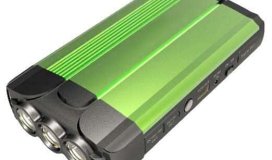A few days ago, I had a conversation with Christopher Wright, the chief operations officer at Gain ICs, an integrated circuit design company based in Colorado. He was all fired up about Gain ICs' technology that, if added to a passive ultrahigh-frequency (UHF) RFID chip, promises to dramatically increase wireless data transmission speeds, read range and tag sensitivity, as well as enable RFID tags to be as inexpensive to deploy as printed bar codes. The technology was invented by the company's CTO and cofounder, Jed Griffin, an engineer formerly with Intel.
Wright says that a passive UHF RFID tag incorporating Gain ICs-based technology would have a read range 31 times greater than that of a tag made with a currently available chip (for instance, from Impinj, Semiconductors or Alien Technology) and the same antenna. In other words, if an EPC Gen 2 tag from Avery Dennison offers a read range of 10 to 30 feet, a tag made with the same antenna design but incorporating a Gain ICs-based chip would have a read range of 310 to 930 feet. Conversely, because a tag made with a Gain ICs-based chip requires so little power to function effectively, a tag incorporating such a chip could be extremely small and still offer a 10- to 30-foot read range. Such a small tag would be cheap to make, Wright says, and would enable item-level tagging of everything, since the tag would not cost much more than the expense of printing a bar code.
What's more, Wright adds, an RFID chip using Gain ICs' technology would be able to transmit data at a rate of 1 gigabit per second—far faster than what today's UHF RFID tags can achieve. (The newly released EPC Gen2v2 standard, like previous versions of the EPC Gen 2 standard, supports a data transfer rate of up to 640 kilobits per second. )#)
If I understand Wright correctly, the primary reason why an RFID chip made with Gain ICs' technology would so efficient is that it produce less phase noise (rapid, short-term, random fluctuations in an RF signal), thereby reducing "jitter" by a factor of 400, 000.
Gain ICs, Wright says, is offering its technology as an intellectual property (IP) block for incorporation into RFID chips. I asked him if the company has made prototype passive UHF RFID tags that perform exactly as he claims, and he responded that no, his firm has not made any prototypes, but that it has proven the technology works via simulations.
I then asked Wright what would need to happen to make such RFID tags commercially available, and he told me Gain ICs is currently seeking development partners to invest in the company.
Whether Gain ICs' technology will ultimately come to the RFID market and live up to Wright's claims remains to be seen. But if it ever does, it certainly sounds as if it has the potential to transform the RFID industry—and the world.



